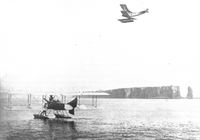
Описание
Страна: Германия
Год: 1914
Варианты
- Friedrichshafen - FF19 - 1914 - Германия
- Friedrichshafen - FF29 - 1914 - Германия
- Friedrichshafen - FF33 - 1915 - Германия
- Friedrichshafen - FF39 - 1916 - Германия
- Friedrichshafen - FF49 - 1917 - Германия
- Friedrichshafen - FF59 - 1918 - Германия
- Friedrichshafen - FF67 - 1918 - Германия
- Friedrichshafen - FF71 - 1919 - Германия
- J.Herris Friedrichshafen Aircraft of WWI (A Centennial Perspective on Great War Airplanes 21)
- Журнал Flight
-
J.Herris - Friedrichshafen Aircraft of WWI /Centennial Perspective/ (21)
The FF19 was the first Friedrichshafen design to be produced in quantity. A total of 16 airframes were built; 15 were delivered to the Navy and one airframe was used for structural testing.
-
J.Herris - Friedrichshafen Aircraft of WWI /Centennial Perspective/ (21)
Friedrichshafen FF19 Marine Number 25 at Borkum wearing late-style insignia. Research by Frits Gerdessen reveals that, on 14 August 1914, Friedrichshafen FF19 seaplane #28 beached at Schiermonnikoog. The plane was later acquired for the Netherlands Navy and the crew, Oberleutnant zur See Hubert Waldemar Klein and Fahnrich zur See Carl Georg Philipp, was interned at Bergen. This was the first of many naval aircraft interned by the Netherlands during the war.
-
J.Herris - Friedrichshafen Aircraft of WWI /Centennial Perspective/ (21)
The first production Friedrichshafen FF19, Marine Number 25, trails a red wingtip identification streamer.
Fdh FF19 (1914). At the request of the Kaiserliche Marine, the FF.19 was developed based on the Avro biplane. The first orders (navy numbers 25-29) were placed by Kiel at the beginning of June 1914. Navy number 62 was subjected to a load test in Friedrichshafen on May 2, 1914.After a 7.02-fold safety was attested, further orders followed (navy numbers 76-85). Note: At the beginning of the war, navy numbers 25-29 were the only navy aircraft capable of front-line use apart from 3 Ago aircraft. (95 hp Mercedes engine). -
J.Herris - Friedrichshafen Aircraft of WWI /Centennial Perspective/ (21)
Friedrichshafen FF19 seaplanes 25 and 26 enjoying unusually calm sea conditions in the Heligoland Bight. They were part of a five-aircraft order placed in February 1914, harbingers of the three-bay Friedrichshafen seaplane layout that became the FF33 when powered by the 150hp Benz and the FF49 when the 200hp Benz was used. This basic design, developed over the following two years, had not been improved upon for general workaday duties by the time of the Armistice, and the later models were the most widely used reconnaissance seaplanes in service.
-
J.Herris - Friedrichshafen Aircraft of WWI /Centennial Perspective/ (21)
Friedrichshafen FF19 Marine Number 78 at Borkum.
-
A.Imrie - German Naval Air Service /Arms & Armour/
Mobilization seaplanes on the ramp at Kiel-Holtenau in August 1914. Aircraft identified in this early wartime photograph include: Rumpler 4B11 (150hp Benz) from Warnemunde, Sopwith Bat-Boat 44 (which was never used operationally but merely for short local flights), Friedrichshafen FF19 23 and Albatros B I on floats, which was another machine taken over on the outbreak of war at Warnemunde. All aircraft are carrying red streamers from the bottom wings near the tips for identification purposes and are marked with the Iron Cross type of national insignia.
Другие самолёты на фотографии: Albatros WDD / W.1 - Германия - 1913Rumpler 4B - Германия - 1914Sopwith Bat Boat - Великобритания - 1913
-
M.Dusing - German Aviation Industry in WWI. Volume 1 /Centennial Perspective/ (84)
A Friedrichshafen FF 19 is placed on wheels to be rolled out of the construction hall.
J.Herris Friedrichshafen Aircraft of WWI (A Centennial Perspective on Great War Airplanes 21)
Friedrichshafen FF19
Although a later design, the FF19 actually flew in April 1914 before the FF17. It featured a three-bay biplane wing cellule that was simpler than the FF17, perhaps one reason it was flown earlier. A tractor floatplane powered by a 100 hp Mercedes D.I, it was the first Friedrichshafen pre-war design to go into limited production, a total of 16 being built.
The first FF19 order for five aircraft, Marine Numbers 25-29, was built in the period 17 May to 18 June 1914 in Kiel. The second order was for 10 aircraft, Marine Numbers 76-85, immediately after the outbreak of war. The FF19s, together with 3 Agos ordered at the same time, were then the only naval maritime aircraft capable of fulfilling a combat role. The 16th airframe was used for static load testing.
The FF19 was historically significant as the first German aircraft from which successful wireless tests were carried out.
Friedrichshafen FF19 Specifications
Engine: 100 hp Mercedes D.I
Wing: Span Upper 15.30 m
Span Lower 13.80 m
Area 48.0 m2
General: Length 10.40 m
Empty Weight 860 kg
Loaded Weight 1,160 kg
Maximum Speed: 95 km/h
Climb: 500 m 8 min
Описание:







